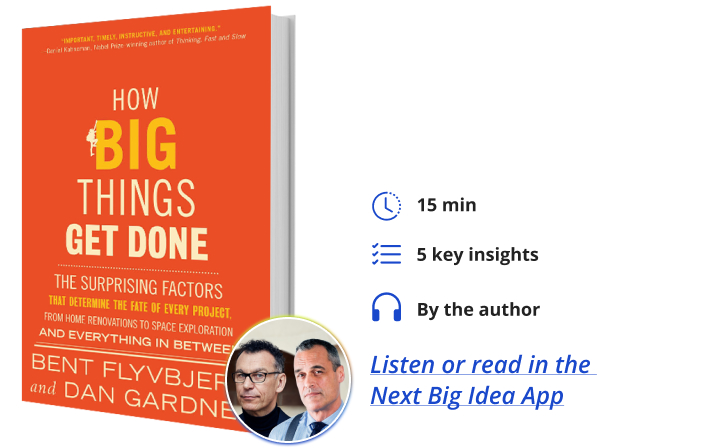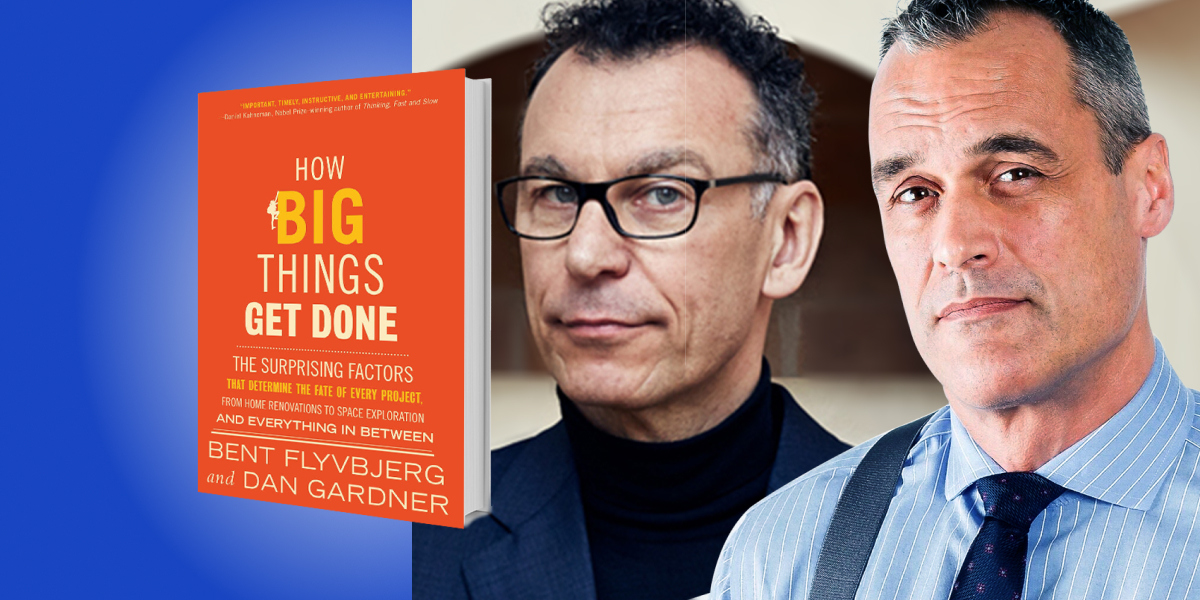Bent Flyvbjerg is a Danish economic geographer and is the Villum Kann Rasmussen Professor and Chair of Major Program Management at the IT University of Copenhagen and the first BT Professor and Chair of Major Programme Management at the University of Oxford.”
Dan Gardner is a journalist, lecturer, and New York Times bestselling author of books about psychology and decision-making.
Below, Bent and Dan share 5 key insights from their new book, How Big Things Get Done: The Surprising Factors That Determine the Fate of Every Project, from Home Renovations to Space Exploration and Everything in Between. Listen to the audio version—read by Bent—in the Next Big Idea App.

1. It’s worse than you think.
Most people know big projects tend to finish late and cost more than they’re supposed to, but few people know just how bad their track record really is. The world’s largest database of big projects now exists and its bottom-line numbers are grim. Nearly 48 percent of big projects finish on budget, eight-and-a-half percent finish on budget and on time, and only half of a percent of big projects finish on budget and on time, delivering the expected benefits.
To put that another way, that means 99.5 percent of big projects fail to deliver all their core promises. Even worse, most categories of big projects have what statisticians call “fat tails.” That means disasters are far more likely than conventionally believed. Disasters like Boston’s “Big Dig” transportation project, which went 228 percent over budget, the Montreal Olympic Games, which went 720 percent over budget, or Scotland’s Parliament which, when it opened in 2004, was an almost unimaginable 978 percent over budget. There is no upper limit to how bad results can get—but they can always get worse.
2. Projects don’t go wrong, they start wrong.
People commonly think the way to get big projects done on time and on budget is to get to work as quickly as possible. Put shovels in the ground right away, push hard, and move fast. That’s how the construction of the world-famous Sydney Opera House started. What people don’t know about the Sydney Opera House is that part way through construction, the project was such a mess they had to dynamite much of what had been built, clear the rubble, and start over. It ultimately took almost three times as long to complete as it was supposed to and the final bill was 1,400 percent over budget, one of the worst overruns in history.
“Projects that start as an excited sprint turn into a long, slow, desperate slog that chews up time and money.”
The problem with rushing to get started is that it means planning will be, at best, quick and superficial. Problems are not identified and solutions are not found and inevitably, trouble surfaces later. Projects that start as an excited sprint turn into a long, slow, desperate slog that chews up time and money. Nobody wants that, so don’t rush to get work started, to swiftly and smoothly deliver a big project, the first thing you must do is slow down.
3. Think right to left.
When David and Deborah decided they wanted to renovate their kitchen, they knew projects could go wrong so they hired an architect to make detailed drawings. Once work got underway, they thought about what other renovations they might like to do in the future. They then thought if the project is already disrupting their lives, why not do that future work now? So they added a new piece to the project, then another, and another. The project slowly changed, growing until the entire apartment had been torn up.
If David and Deborah had planned to gut the apartment from the start, this work could have been carried out as efficiently as possible. But their project expanded haphazardly. So it was done at maximum cost, time, and aggravation. This disaster could have been avoided if they had simply started the project by asking themselves a simple question, “Why are we doing this project?” We don’t do projects for the sake of doing projects, we do them because they deliver the benefits we want. What exactly were the benefits David and Deborah wanted? If they had really explored their motivations, the thinking that led them to expand the kitchen renovation piecemeal would have surfaced at the beginning instead. They would have fully discussed it, then chosen from a wide range of options, and any other option they would have chosen would have been better than what they did.
“We don’t do projects for the sake of doing projects, we do them because they deliver the benefits we want.”
On project management charts, the end goal is on the right, and the beginning of the project is on the left. Successful projects begin by deeply understanding what that end goal is, and then they work backward, which is thinking right to left.
4. Simulate and iterate.
Frank Gehry is a world-famous architect; Pixar is an Oscar-winning movie studio. One makes buildings; the other makes animated movies. Their projects would seem to have nothing in common, but Frank Gehry and Pixar are both successful, in part, for the same reason: They see planning as a chance to dream up new ideas, try them out, and make sure they work.
In a phrase, they simulate and iterate. Frank Gehry starts with sketches and wooden models, but eventually, he and his team create a digital simulation of the future building that is so precise and detailed that it can be called a digital twin. Gehry uses this simulation to relentlessly test his ideas and ensure that everything, from the overall vision to the smallest structural detail, is up to his demanding standards.
Pixar’s directors do something surprisingly similar. They start with a rough outline, then a script. Artists draw simple storyboards illustrating scenes. The boards are photographed and strung together into a video, voices are dubbed in, the video is shown to an audience and the director gets feedback. Then the director goes back, dreams up new ideas, and repeats the whole process, over and over again.
“They see planning as a chance to dream up new ideas, try them out, and make sure they work.”
If you think this process is a lot of work, you’re right. It takes time and discipline, but it’s worth it because simulating and iterating produces an extremely detailed, highly reliable plan. With a plan like that in hand, delivery is far more likely to be smooth and swift and lead to a successful project.
5. It takes a real team.
Airport terminals are among the toughest projects to deliver on time and on budget. They’re huge, they’re complex, and to build an airport terminal, you have to bring together thousands of people from dozens or hundreds of organizations and somehow turn them into a motivated, creative, cooperative team. Most such projects fail, but Terminal 5 at London’s Heathrow Airport proved that it can be done.
Project leaders started by using contracts that didn’t give people and companies incentives to blame the other guy when something went wrong. Project leaders also treated the workforce respectfully; they really listened to workers, at all levels, and gave them everything they needed to be safe, comfortable, and do good work. Leaders also emphasized that the project—not the client, contractor, or sub-contractor—came first. They made it clear to everyone what the project’s goals were and why the project mattered.
They also developed what organizational psychologists call “psychological safety,” meaning a sense that workers were free to speak up if they felt something had gone wrong or could be done better. Put all that together, and people felt that they were on the same side, believed their contribution could make a difference, and had a shared identity and purpose. That is a real team. The fact that the terminal was built by a real team is the single biggest reason why the project beat the odds and finished on budget and on time.
To listen to the audio version read by co-author Bent Flyvbjerg, download the Next Big Idea App today:































